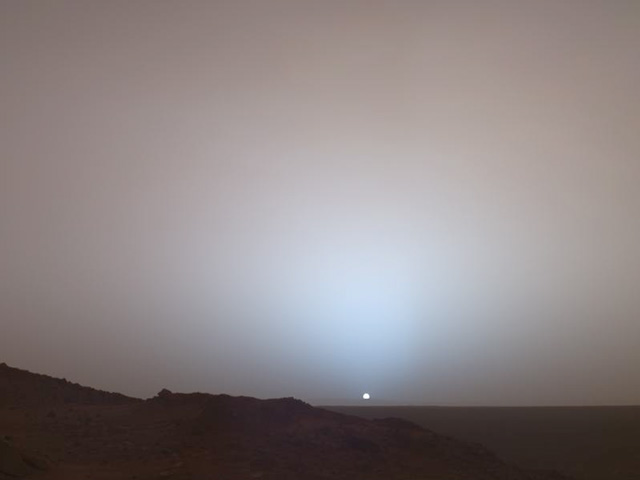Explanation: What would it be like to see a sunset on Mars? To help find out, the robotic rover Spirit was deployed last month to park and serenely watch the Sun dip below the distant lip of Gusev crater. It was a tough job, but some robot had to do it. Now on Earth a red sunset is caused by two effects -- by blue light being preferentially scattered out of sunlight by oxygen and nitrogen molecules in the atmosphere, and by scattering off a small amount of impurities like volcanic dust. (The magnitude of the first effect was computed in one of Albert Einstein's most cited papers.) Although Mars lacks oxygen and nitrogen, it is covered in red dust frequently hoisted into the atmosphere by fast but thin winds. Analyses of images like the above photograph show that at some Martian days are capped by a sunset significantly longer and redder than typical on Earth. For up to two hours after twilight, sunlight continued to reflect off Martian dust high in the atmosphere, casting a diffuse glow. The result helps atmospheric scientists understand not only the atmosphere of Mars, but atmospheres across the Solar System, including our home Earth.
1999 2000 2001 2002 2003 2004 2005 2006 2007 2008 2009 2010 2011 2012 2013 2014 2015 2016 2017 2018 2019 2020 2021 2022 2023 2024 2025 |
Yanvar' Fevral' Mart Aprel' Mai Iyun' Iyul' Avgust Sentyabr' Oktyabr' Noyabr' Dekabr' |
NASA Web Site Statements, Warnings, and Disclaimers
NASA Official: Jay Norris. Specific rights apply.
A service of: LHEA at NASA / GSFC
& Michigan Tech. U.
|
Publikacii s klyuchevymi slovami:
Mars - Gusev crater - sunset - Mars - zakat
Publikacii so slovami: Mars - Gusev crater - sunset - Mars - zakat | |
Sm. takzhe:
Vse publikacii na tu zhe temu >> | |
